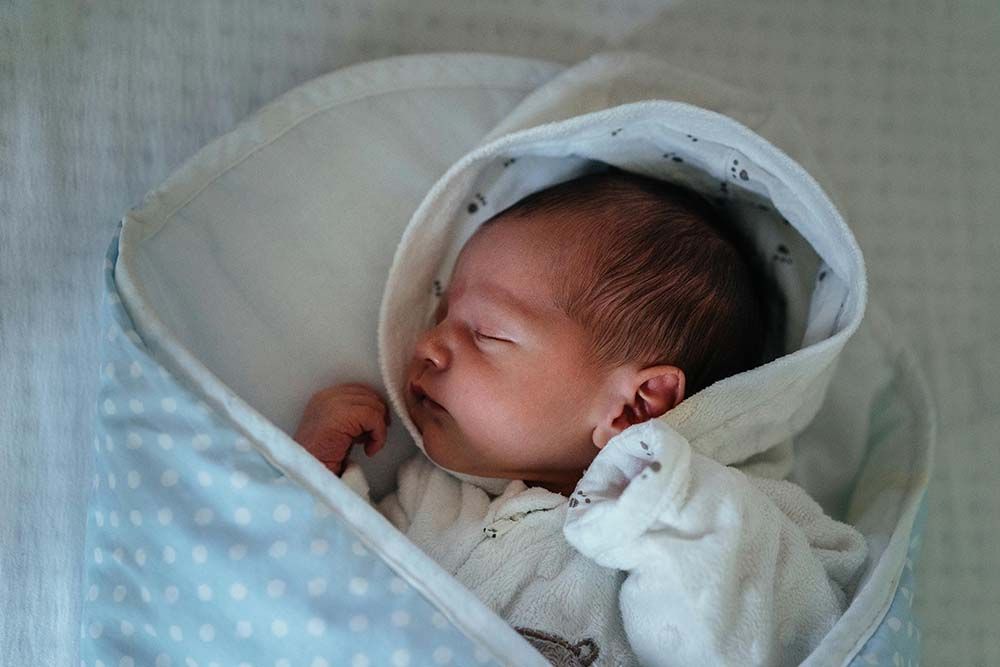

Standing is an important developmental milestone for babies. But, when do babies start standing on their own? How to help babies stand without support? How to keep babies’ safety during the learning process? Such more related issues about standing come subsequently. If you want to know the answer, read on for more.
When do Babies Start Standing on Their Own?
Babies usually start standing on their own between 9 and 12 months old. At this age, babies begin to show more powerful muscle strength and better coordination, which can try standing without external assistance. At the first few months, babies can only kick legs unconsciously to exercise the leg muscle strength, transitioning to being able to bear weight with the help of parents. Generally speaking, when a baby's leg muscles are strong enough to support their entire body weight, they are likely to attempt to stand by leaning on furniture or other objects. Over time, around 10 to 12 months old, many infants are able to briefly stand independently.
It should be noted that every baby has their own growth rhythm. Some babies may be born with strong muscle strength and well-developed bones, who may learn to stand on their own earlier than their peers. And some babies may be slightly delayed due to their own physical condition and other reasons. Additionally, genetic factors may also play a role in it. If their parents develop large movements such as standing and walking earlier in childhood, babies may also have similar tendencies.
Is it Bad for Babies to Stand Too Early?
It is important to understand that the development of a baby's body is a gradual process, and the pace of each baby's development is different. Generally speaking, if a baby tries to stand during natural exploration, it is usually safe even if it appears earlier than other children of the same age. However, there are a few points to note:
Support and protection: Ensure that the baby has a safe environment to practice standing, avoid falls and injuries. Be particularly careful when using a walker, as improper use may result in accidental injury.
Natural development: Encourage babies to develop at their own pace, rather than forcing them to do things they are not yet ready to do. Making babies to stand or walk for long periods of time too early (such as through continuous pulling of their arms by adults) may affect their natural development process.
Observe abnormal behavior: If you notice that your baby exhibits abnormal behavior while standing, such as tiptoeing, asymmetrical leg posture, or frequent falls, you should consult a pediatrician in time to rule out any potential health issues.
Overall, as long as the baby explores standing naturally and under adult supervision, it generally does not cause harm to the baby. The most important thing for parents is to provide a safe and supportive environment for their babies, allowing them to freely explore and develop their physical abilities.
What are the Signs That Your Baby is Ready for Standing?
If babies show interest in standing, are able to support their weight, and try to stand while supporting objects, then they may be ready to try standing. This process is usually gradual and will show a series of signs, indicating that the baby's muscle strength, balance, and coordination are gradually increasing and preparing them for standing. Here are some common signs:
Increased leg strength: When the baby is in a prone position, they can lift their chest and upper body, or kick their legs with the support of parents, showing that the strength of their leg muscles is increasing.
Standing with support: When a baby begins to show interest in furniture, walls, or other supports around them and tries to grab onto them, this is a clear signal for standing. Babies may use their hands to grab onto tables, sofas, or parents' hands to help themselves stand up.
Crawling: Most babies learn to crawl before they learn to stand. Crawling helps strengthen the baby's arms, legs, and back muscles, while also improving their sense of space and balance.
Improved body coordination: Babies begin to have better control over their head, neck, and torso movements, allowing them to move and switch positions freely while sitting.
Interest and curiosity: The baby will show a strong desire to stand up to gain a higher perspective around their surroundings. He may look at the people standing around him with curiosity, and try to imitate them through his own efforts.
How do Babies Start Standing on Their Own?
Learning to stand on their own is a comprehensive skill development process for infants, involving the cultivation of muscle strength, balance, coordination, and courage. Through continuous practice, gradually reducing dependence on support, and trying again after falling, infants will eventually master the skill of standing independently. Typically speaking, babies can stand usually between 9 and 12 months. However, this process may vary because each baby’s growth speed is different.
1. Strength accumulation stage (0-6 months)
Within a few months after birth, babies begin to accumulate muscle strength in their legs. Starting from the initial unconscious kicking movement, the kicking becomes more powerful and rhythmic over time.
When babies grow up to be able to sit upright, they will naturally move their legs. For example, when sitting on a baby chair, they may use their feet to step on the edges of the chair, or when sitting on the ground, they may use their feet to explore surrounding objects. These movements not only further enhance the strength of the leg muscles, but also allow the baby to gradually adapt to the feeling of the legs bearing the weight of the body.
Additionally, the strength of the core muscles (abdominal and back muscles) is also developing synchronously. Babies develop their core muscles through the process of lifting their heads, turning over, and being able to sit steadily on their own. Good core muscle strength is one of the key factors for infants to maintain balance, providing support for leg strength.
2. Balance building stage (6-7 months)
After learning to sit upright, babies begin to try to maintain balance while sitting. They will adapt to different posture changes through small adjustments of their bodies. For example, when reaching for a nearby toy, babies will unconsciously twist their bodies and use their core muscles to maintain a stable sitting posture. The initial establishment of this sense of balance laid the foundation for standing.
Subsequently, the baby will use surrounding objects to explore balance. They will first grab onto objects such as bed rails and sofa armrests to maintain balance. During this process, infants will gradually discover how to adjust the grip position of their hands and other parts of their body to maintain balance when leaning forward or backward.
3. Try standing stage (8-10 months)
When the leg muscle strength and balance reach a certain level, babies will actively try to stand. They will use their mastered balance techniques to lift themselves up. At the beginning, this standing may be brief and the baby's posture may be stiff. But with the accumulating experiences, their standing time will gradually increase.
4. Independent Standing Stage (11-12 months)
After multiple exercises of standing with support, babies will begin to try to stand independently. They will carefully release their hands holding onto the object, relying on their own muscle strength and balance to maintain standing. At the beginning of standing independently, it may only last for a few seconds, but this is already a huge improvement.
With continuous practice, babies will stand independently longer and their posture will become more natural. They will gradually learn to maintain a stable standing posture and ultimately achieve the ability to stand freely on their own.
How to Help Your Baby Stand Without Support?
To help your baby stand better, you can adopt the following methods. But please keep in mind that every baby has their own pace, and there is no need to worry about. The best way is to patiently wait for the baby to develop naturally.
1. Enhance muscle strength
Encourage your baby to do more prone lying time every day, which can help strengthen the muscles in the neck, back, and arms. Additionally, gently help babies kick their legs while they are lying down to strengthen their leg muscles.
2. Encourage sitting and crawling
Encourage babies to sit more, which can help improve balance. And crawling helps to enhance the strength of the arms, legs, and core muscles, while improving spatial awareness and balance.
3. Provide support items
Give babies the opportunity to stand on furniture (such as sofas, small tables). Ensure that the furniture is stable and will not tip over. When babies try to stand, parents can also gently support their armpits or waist with their hands to provide necessary support.
4. Use toys and games
Place your baby's favorite toys where they need to stand up to reach them, stimulating their motivation to stand up. Also, you can play interactive games with your babies to guide them to stand, such as gently holding their hands to help them stand, or having them stand on your legs and shake or dance together.
5. Assisted by a walking cart
Using a walking bike (with appropriate support to ensure safety) allows babies to practice walking. Although babies may not walk completely independently, this practice helps their muscles and coordination when standing and walking.
6. Gradually reduce support
After the baby is able to stand with support for a time, parents can try to gradually reduce their baby’s dependence on the support. For example, you can let the baby go from supporting your hand to supporting a finger, and then completely letting go.
7. Actively encourage and praise
Every time the baby tries to stand, parents can give them positive encouragement and praise to boost their confidence. Since each baby's development speed is different, and some babies may need more time to master standing skills. At this time, parents need to maintain patience, do not excessively intervene or force the baby, give babies enough time and space to develop.
8. Observation and Consultation
Parents are supposed to pay attention to babies’ behavior while practising standing. If a baby exhibits abnormal behavior, such as tiptoeing, asymmetrical leg posture, or frequent falls, they may need to consult a pediatrician to rule out any potential health issues.
9. Pay attention to the safety of the baby
Ensure that the surrounding environment of the baby is safe. Clean up any items that may cause the baby to fall, make sure there are soft cushions or carpets around to prevent injury when the baby falls.
How to Keep Babies’ Safety When They Learn to Stand?
Ensuring the safety of infants when learning to stand is the top priority for parents and caregivers, as their balance and coordination abilities are still developing during this stage, and they are prone to falling or injuring themselves. Here are some suggestions to help babies stay safe while learning to stand:
1. Clean and organize the environment
Remove hazardous materials: Ensure that there are no sharp edges, fragile items, or small objects in the room that may cause injury when the baby falls.
Fix furniture: Fix tall furniture (such as bookshelves, TV cabinets) on the wall to prevent them from tipping over when the baby climbs.
Use protective corners: Install protective corners or strips on sharp edges of furniture to reduce injuries during collisions.
2. Use anti slip measures
Anti slip pad: Place anti slip pads or soft cushions on the floor, especially in areas where babies often move around, such as the living room and bedroom.
Soft flooring: Choose soft carpet or flooring materials to reduce the impact force when a baby falls.
3. Supervision and companionship
Adult supervision: During the process of babies learning to stand, there should always be adult companionship and supervision to prevent accidents from happening.
Close range care: Try to stay close to the baby and be ready to provide help and support at any time.
4. Wear appropriate shoes
Barefoot is the most advantageous: If indoors, babies can stand barefoot because barefoot helps improve balance and muscle strength in the feet.
Wear appropriate shoes: When babies start standing outdoors or on hard surfaces, they can be dressed in soft and supportive shoes
5. Pay attention to floor cleanliness
Keep the ground dry: Ensure that the ground is clean and dry, and avoid slippery conditions that may cause babies to slip.
Clear obstacles: Promptly clean up wires, toys, and other obstacles on the ground to prevent babies from tripping.
6. Check the safety of doors and windows
Lock the windows: Ensure that all windows have safety locks to prevent accidents when babies climb.
Door stopper: Install a door stopper under the door to prevent the door from suddenly closing and injuring the baby's fingers.
7. Pay attention to the baby's emotions and physical fitness
Ensure that the baby's mental state is good: When the baby is tired, hungry, or unhappy, they may lose balance or fall easily. Observe the baby's body language to ensure that they are doing standing exercises in an appropriate emotional and physical state.
Avoid excessive practice: If the baby feels uncomfortable or does not want to stand, respect their needs and do not force them to continue standing.























